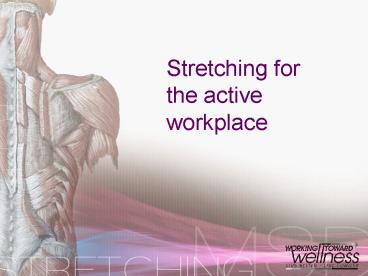Stretching for the active workplace - PowerPoint PPT Presentation
1 / 20
Title:
Stretching for the active workplace
Description:
Sitting at a desk or computer can lead to muscle tension, ... affect both men and women; however, men are more likely than women to suffer from an MSD. ... – PowerPoint PPT presentation
Number of Views:1925
Avg rating:3.0/5.0
Title: Stretching for the active workplace
1
Stretching for the active workplace
2
Whether you work at a desk or computer, or work
in a manufacturing job, it is important to take
measures to protect yourself from a
musculoskeletal disorder (MSD).
3
What is a Musculoskeletal Disorder (MSD?)
An MSD is an injury that can affect the bones,
muscles, tendons, ligaments, blood vessels,
nerves, or joints. Sitting at a desk or computer
can lead to muscle tension, stiffness, and strain
in the neck, shoulders, arms, wrists, back, and
legs which can lead to an MSD.
4
Alarming facts
- MSDs are the most common cause of severe
long-term pain and physical disability - MSDs can affect both men and women however, men
are more likely than women to suffer from an MSD.
- Sprains and strains account for 48 of lost time
claims (WSIB, 2005).
5
- MSDs can result from several factors
- Your level of fitness (muscle strength,
flexibility, and endurance) - Your age
- Your workplace job requirements
6
Prevention of MSDs
- There are several ways to help prevent MSDs,
including - Maintaining proper posture
- Strengthening muscles
- Increasing flexibility through regular
stretching - This presentation will focus on stretching at
the workplace.
7
The Benefits of Stretching
- It relieves muscle tension and can help reduce
stress - It increases your range of motion, which promotes
flexibility and makes everyday activities easier - It increases blood flow to the muscles and
surrounding tissues
8
Stretches For The Active Workplace
- The following 9 stretches are designed
specifically for those who work in an active
workplace. - Perform these stretches daily for maximum
benefits - Hold each stretch for 20-30 seconds
- You should feel a gentle stretch, not pain when
stretching. Stop if you feel pain.
9
1) Neck RollLower your chin towards your chest.
Slowly roll your head towards one shoulder,
return your head centre, and then slowly roll
your head to the opposite shoulder. Repeat.
10
2) Shoulder RollInhale as you lift and roll your
shoulders backwards. Exhale as you roll your
shoulders down and back, squeezing your shoulder
blades together. Repeat and then switch
directions.
11
3) Upper Back / Shoulder StretchWith shoulders
relaxed, bring one arm across your body, using
your hand to pull the arm towards your body until
you feel a stretch in the upper back. Repeat with
opposite arm.
12
4) Chest StretchStanding upright, pull your arms
behind you. Squeeze your shoulder blades together
and reach your arms back until you feel a stretch
across the chest.
13
5) Overhead StretchWith one hand on your hip,
reach overhead with opposite arm and slowly bend
at the waist towards the hip you are holding.
Repeat on opposite side.
14
6) Lower BackStanding with knees bent, place
your hands on your thighs, lower your head,
tuck-in your tailbone, pull in your abdominal
muscles, and curl your spine towards the ceiling.
15
7) Quadriceps StretchWhile standing, place one
hand on a nearby surface. Bend one leg at the
knee, bringing your heel towards the buttocks
while holding your foot or ankle. Repeat with
opposite leg.
16
8) Hamstring and Calf Stretch While standing,
place one foot in front of you, toes pointed up
towards the ceiling. Shift your weight to the
back leg and bend the knee as you sit/lean back.
Pull your toes towards you until you feel a
stretch in the hamstring and calf muscle. Support
your upper body weight by placing your hand on
your leg, just above the knee. Repeat with
opposite leg.
17
9) Ankle RollLift one foot off the floor. Begin
by pointing your toes towards the ground and then
rolling your foot clockwise, then
counterclockwise. Repeat for opposite foot.
18
Key Messages
- Flexibility is a key component of MSD prevention
- Flexibility allows for relaxed muscles and mobile
joints. - Remember to stretch daily for maximum benefit.
19
Active Living at Work
- For more information, visit
- Alberta Centre for Physical Activity _at_ Work
- www.centre4activeliving.ca/workplace
- Active Living at Work
- www.phac-aspc.gc.ca/pau-uap/fitness/work/
- Mayo Clinic Focus on Flexibility
- www.mayoclinic.com/health/stretching/HQ01447
20
Key References
Workplace Safety and Insurance Board (2005).
Statistical Supplement. Retrieved July 13, 2007,
from http//www.wsib.on.ca/wsib/wsibobj.nsf/Lookup
Files/DownloadableFile2005StatisticalSupplement/F
ile/2278A_StatSup.pdf Woolf, A. D., Phleger,
B. (2003) Burden of major musculoskeletal
conditions. Bulletin of the World Health
Organization, 81(9).































